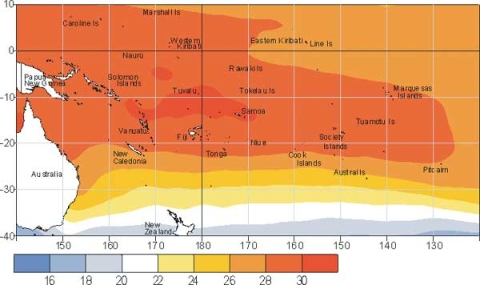ENSO and Sea Surface TEmperatures
Conditions are set for the development of an El Niño
Warmer than average seas across the whole of the tropical Southwest Pacific
The likelihood of an El Niño developing this year, based on recent observations in the equatorial Pacific, has increased. The equatorial Pacific Ocean temperatures are becoming warmer than average especially near South America where anomalies now exceed +1.0°C, The Southern Oscillation Index showed a substantial fall (to -0.8) in March, from weakly positive values over the previous two months. The March OLR data showed extensive positive anomalies (indicating decreased convection) from Sumatra in Indonesia across northern Australia to the western Coral Sea, while enhanced convection and high rainfall was observed off the west coast of South America near Ecuador. The global forecast models show a strong consensus. All these factors point to an increased likelihood of an El Niño developing. There are no significant anomalies in the Pacific equatorial trade winds at this stage. The next few months will be critical to the development of an El Niño episode.
In the tropical Southwest Pacific, a very extensive area of much warmer than usual water at the surface (at least 1.0°C above average) extends from New Caledonia through to the region well east of Pitcairn Island, encompassing most islands between 15 and 25°S. A region of positive SST anomaly (of at least 1.0°C above average) is well established around Western Kiribati. The warmest surface waters (30-31°C) extend from northern Vanuatu across to Samoa. Sub-surface sea temperature observations show positive anomalies from 160°W to the coast of South America, with the (relatively) warmest water near 50 m depth in the far east at 100-120°W.
Sea surface temperature anomalies (°C) for March 2002

Mean sea surface temperatures (°C) for March 2002

